It’s better to have a drill press that is too sturdy than one that isn’t sturdy enough. If a tool is poorly made, you will find out in short order and be able to return it.
On the other hand, you wouldn’t want to buy a drill press that isn’t heavy enough for your needs and has to try to return it because it won’t stay put.
Drill presses are a little top-heavy, but a person exercising common sense won’t have any trouble with one. No need to bolt a floor-model drill press down. It’s actually nice to be able to move it around on a mobile base to accommodate long projects once in a while.
Table of Contents
Does a Drill Press Need To Be Bolted To The Floor?
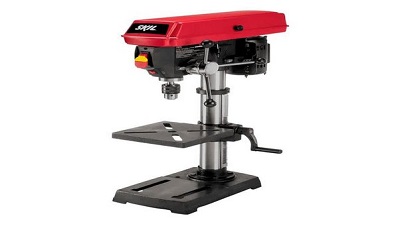
Safety Measures
The bigger concern for safety with drill presses is the chuck key being left in the chuck of the running machine. You see this all the time on YouTube, and if you do happen to forget the key in there after changing bits, it can be very dangerous.
Generally, you don’t bolt a drill press to the floor unless it’s a really big one. The big ones are not only tall but heavy. A DP sitting on a mobile base is more convenient because you can move it around to suit the project. A much larger tool would be a milling machine.
A drill press is a lot like a very heavy table saw. There are some small differences, but the tables are about the same height and have large, heavy cast iron bases.
The top is quite heavy and may not be balanced very well with all the accessories on it, but it’s not going to be much different than your table saw.
If you have a mobile base for your table saw and you use common sense when pushing it around, you should have no trouble moving your drill press around on one. Just don’t tilt it toward you or try to roll it up steps.
What is a Drill Press?
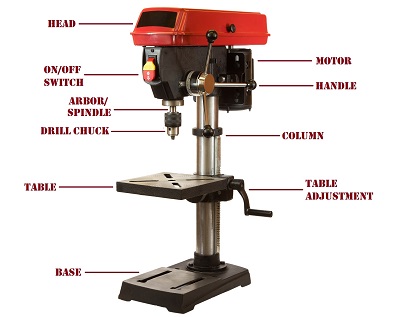
A drill press, also known as a pedestal drill or a “pillar” drill is a fixed style of drill that may be mounted on a stand or bolted to the floor or workbench. A large version of the radial arm drill may have up to five-speed step pulleys to control the speed.
A drill press uses a powerful electric motor to drive the chuck at variable speeds and has controls for raising and lowering the chuck into the material, as well as adjusting the speed of rotation.
A drill press may have more than one gearbox that allows it to rotate at different speeds, depending on the size of the hole being drilled.
Drill presses are recommended for drilling through metals, and larger holes in wood. They are also used for other materials such as glass, ceramics, plastics, composites, and alloys.
Drill presses were traditionally bench-mounted tools but since the introduction of portable battery-operated devices, the distinction between a drill press and a standard portable drill has blurred.
How Do You Secure a Drill Press To The Floor?
For the drill press to work properly and safely, you must firmly secure it. There are several ways to do this:
Secure Drill Press To The Floor
This is done if you have a floor model that weighs more than 100 pounds. To do this, use bolts that are screwed into the floor, or use a special bracket bolted to the floor.
Secure a Bench Top Drill Press
This is done by placing it on a solid stand or table, which will serve as a stand for the device. The optimal weight of such a table should be at least 500 pounds (227 kg).
It is better if it has wheels or casters so that you can move the device to any place in your workplace. It may also be attached with bolts or clamps to the base of the table.
Holding Drill Press In Your Hands
You can also hold your hand drill press in one hand and fasten it on yourself by using a belt with loops for tools or fasteners for tool holders on your clothes.
How Do You Secure a Bench Top Drill Press?
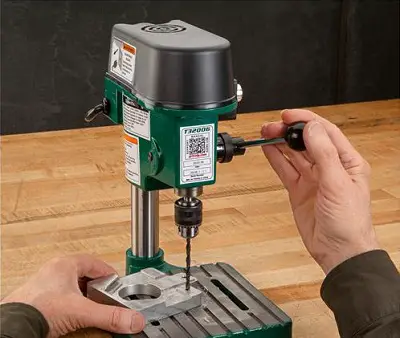
If you plan to use your drill press for woodwork then you will want to secure it to the floor. The best way to do this is by using nails and bolts. If the press is light enough, then you will only need nails; however, if it is heavy then you may want to use both bolts and nails.
If the drill press is going to be used for drilling, then you will want a vise that can be secured to the base of the table with bolts or screws. The table should also have some sort of clamping mechanism so that it does not move around too much when being used.
When using your benchtop drill press, there are several ways to secure it:
- If you have a long enough bench, you could use clamps or a couple of C-clamps
- You could also use some strong adhesive tape such as duct tape or masking tape
- If neither option works for you, then just make sure that there are no sharp edges on your work surface and that nothing else could possibly fall onto it (such as tools or other objects).
How Do You Secure a Wood Drill Press?
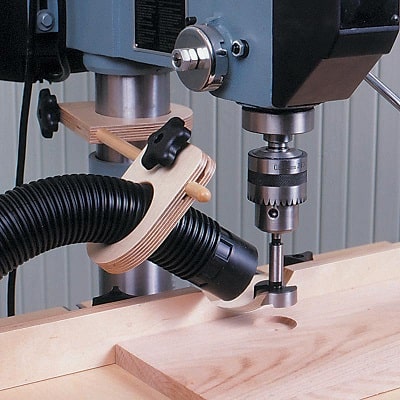
You can secure a drill press to the floor by placing it on top of a non-slip mat and screwing the mounting holes down. If your press has adjustable legs, you can place cinder blocks around them for added stability.
If your drill press is portable, consider using a stand or table to keep it from moving around. Some models come with a built-in clamp, which will help the press stay in place when you’re using it.
You may also want to use a vice to secure your workpiece while drilling into it. This will prevent slippage and ensure that your press gets maximum purchase on whatever material you’re working with.
You secure a drill press to the floor by bolting it to the floor.
You secure a benchtop drill press by having a low center of gravity and weight on the base. You secure a wood drill press by anchoring it to a workbench or table with clamps and/or bolts, screws, or nails.
A drill press should be held in place by having its four legs sitting on the floor, and one or more sets of securing bolts running through holes drilled into the floor.
If you are using a benchtop drill press, then you should also bolt it to your workbench to ensure that it does not move as you are working with it.
How Should Drill Press Be Held?
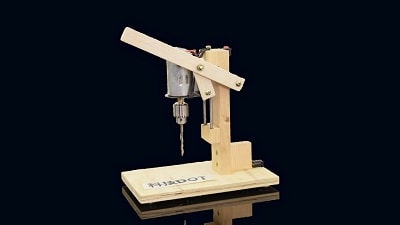
Drill presses can be dangerous, so it’s important to secure them properly. Most drill presses come with a bracket that you can use to bolt the machine to your workbench. Drill presses can also be bolted to the floor for added stability.
If you’re working on a workbench that is not attached to the floor, make sure that you bolt the bench and the drill press down separately.
You can also purchase a drill press stand, which is designed to hold a drill press securely without having to bolt it to anything.
A drill press or a drilling machine is a fixed style of drill that may be mounted on a stand or bolted to the floor or workbench. The drill head is mounted in a spindle that can be moved up or down via a crank and that, in turn, moves the chuck and bit into the material being drilled.
The spindle can also be tilted to varying degrees to allow the operator to perform angled drilling.
Do I Need To Bolt Down a Drill Press?
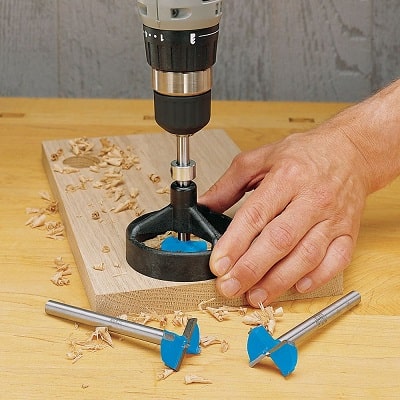
It is recommended that you bolt down the drill press. This will help stop unnecessary movement in the machine and prevent accidents from happening. As there is a lot of torque and power involved in using a drill press, it could get knocked over when it is not bolted down.
It’s certainly true that in some cases you might want to bolt your drill press down. If you are using it regularly and will be drilling holes through very hard materials, then you might want it bolted down in order to avoid any movement which could cause an accident or damage the machine.
How Many Holes Does a Drill Press Have?
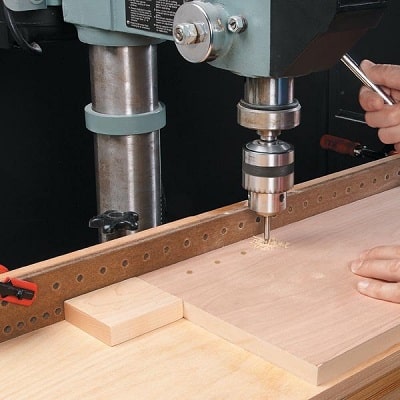
The number of holes in the drill press will depend on how big the machine is. Smaller machines can have one or two holes, while larger machines may be able to have four or more holes. The more holes there are, the easier it is to drill into bigger and thicker pieces of metal or wood.
There are three basic varieties of benchtop drills. Each has advantages and disadvantages. These are:
- The column-and-boom type is handy for small workshops, but has limited depth capacity and is limited in drilling, reaming and tapping capacity by its size;
- The variable-speed type (which uses V belts) is useful when changing speeds often is needed;
- The gear-reduction type (with usually two constant speeds) is more rigid than the other two types, and can handle larger drills and heavier work with greater stability.
Can a Drill Press Be Knocked Over?
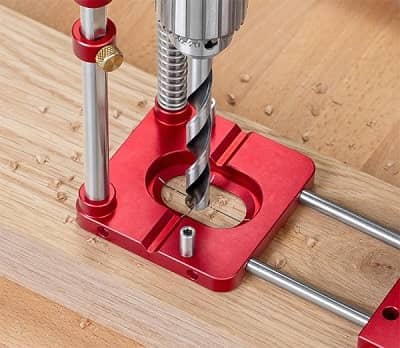
Yes, any type of drill can knock over if it is not bolted down to the ground properly. You should always use safety precautions when operating a drill press because there are fast-moving parts involved. If you are not careful and do not watch what you are doing, then someone can get hurt easily.
It is very rare for a drill press to be knocked over. However, if you are using one in an industrial setting, you might want to consider using some kind of safety device such as a safety harness to prevent this from happening.
Frequently Asking Question
1. Do Drill Presses Need to Be Guarded?
Yes, all drill presses must be guarded by a hinged or adjustable guard to prevent accidental contact with the cutting tool. A drill press is a tool that you need to be very careful when using.
Normally, all the accidents that happen in drill presses are caused by negligence, so you need to be aware of what are you doing and follow all the safety precautions.
2. What PPE Is Required When Operating a Drill Press?
PPE includes safety glasses, protective footwear, and hearing protection. This is standard PPE for any machine shop. The first thing that you need to do is to inspect the machine for any damage before you start using it, especially for cracked or bent parts. If you notice any damages to the machine, immediately report the damage to your supervisor and make sure to get it fixed.
3. Why Is Spotting Important Before a Hole Is Drilled?
Spotting allows the operator to make sure holes are located properly and prevent mistakes.
4. Do Drill Presses Need Special Bits?
Yes, most drill presses use high-speed steel bits that are designed for drilling metal at high speeds. You should never stand directly in front of a drill press when operating it because it may cause injury if something were thrown off from underneath the tabletop such as debris.
Wrap Up
A drill press consists of a base, column, table, spindle or quill, and drill head. The base and column support the entire machine. The table can be adjusted vertically and horizontally to accommodate different sizes of workpieces. The spindle is driven by a powerful electric motor in the drill head.
Power drills and drill presses are useful tools. They can be used to drill holes in wood, metal, plastic, and other materials. If not used carefully, however, they can also be dangerous. The main purpose of a drill press is to make holes. The workpiece can be stationary or rotating.
